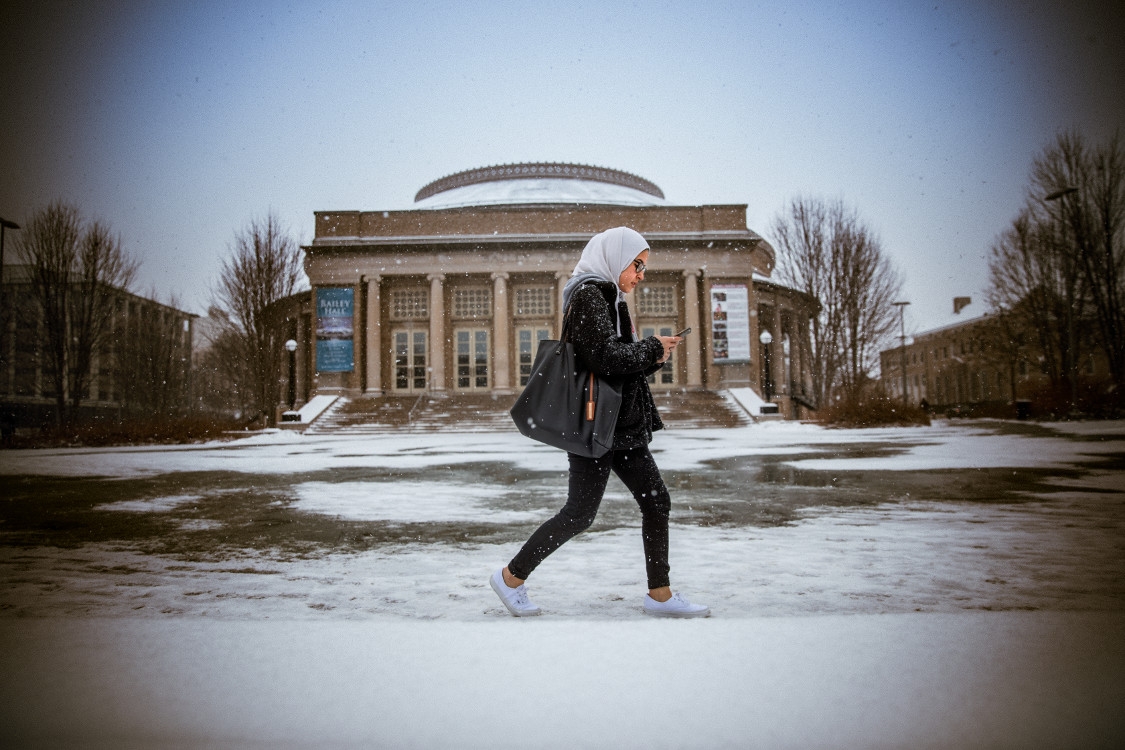
With much of the Cornell workforce and student population working flexibly or fully remote during the COVID19 pandemic, was campus energy use drastically reduced through most of 2020?
Decreased energy offset by new ventilation needs
Fall 2020 did see a decrease in overall campus electricity, heating, and cooling use for campus buildings connected to the Cornell Central Energy Plant. Cornell's campus is primarily driven by a district energy system that provides these three functions to the majority of campus buildings, though some buildings owned by Cornell are outside of this system and not included in the calculations below.
Total energy use for heating, cooling, and electricity use from September - November 2020 was down 6% over the previous time period in 2019. Although a reduction of campus services, on-campus student population, and workforce contributed to the energy reduction, other factors also contributed. The weather in September and November of 2020 were milder relative to last year, lowering heating energy consumption.
For the safety of human health and to ensure greater indoor air quality safety during the pandemic, Cornell installed, enhanced, and created many new building air handling and ventilation systems that draw more energy than in previous years, offsetting some of the reduced COVID operational impacts. Campus HVAC systems were optimized in alignment with national guidelines developed by an epidemiology building engineering taskforce. Implemented changes included extending the hours of building air-handling or HVAC systems' operation to ensure both a pre-occupancy and post-occupancy "flush" of air in buildings, upgrading filters to MERV-13 filters which provide additional air filtration capacity over usual ventilated systems, updating backend electronic building controls to allow for greater ventilation rates, and implementing temporary ventilation measures to improve fresh air flow where major HVAC ventilation was not already present.
For the safety of human health and to ensure greater indoor air quality safety during the pandemic, Cornell installed, enhanced, and created many new building air handling and ventilation systems which draw more energy than in previous years, offsetting some of the reduced COVID operational impacts.
In Spring, at the onset of the pandemic and the University closing down, the Cornell University Energy Management team, part of the Energy & Sustainability Department in Facilities & Campus Services, orchestrated a campus-wide effort to quickly scale down energy use in buildings that were unoccupied or unused for a period of time.
With buildings completely vacant, temperatures were reduced and system operation was minimized to save energy. This work resulted in a 14% reduction in budgeted campus utilities from March to June.

Varied results across campus
Energy consumption was varied across campus buildings depending on changes in occupancy and use. For instance, the Statler Hotel and Statler Hall saw significantly lower energy use than typical across the Fall semester. And campus water use was down overall 20% relative to 2019.
Other buildings saw some increase in energy use due to expanded ventilation systems and overall occupation, including the Animal Health Diagnostic Center (AHDC). AHDC had increased building energy airflow by 15% to accommodate COVID protocols with staff and student occupancy, leading to increased utilities across the board. AHDC is one of several on-campus COVID testing sites.
Winter Break
Comparing energy use between 2019 and 2020 in the month of December, the campus overall used less energy in 2020. 16MW appears to be the minimum campus load possible during the least occupied days. It is worth noted that there were fewer overall working days in December 2020 as compared to 2019. The typical campus load during winter break was increased by about ½ MW, about a 3% increase compared to historical operations during the holiday.
It's important to note that some buildings that Cornell would normally shut down during this time period could not be scheduled for less energy use, due to continued occupancy. Those buildings that were still operating had higher filtration loads, higher ventilation loads, and longer operating times.
Less Energy, More Wellness
Overall, energy and utilities savings due to reduced use and occupancy of campus facilities was offset in part by increased health and safety standards for those who were occupying, working, studying, and using campus facilities. Since the definition of 'sustainability' includes people, prosperity, and planet - and for Cornell, a fourth bottom line of academic and educational purpose - the overall impact of the pandemic measures should be seen as a success. Most important is the preservation of human health and life, which the fast implementation of new building ventilation, occupancy protocols, and social distancing by all members of the campus community helped to ensure.
Continue practicing safe protocols on campus and at home. It's up to all of us to prevent and slow the spread of COVID19. For more information on how to stay safe during the pandemic, visit the Cornell COVID page.
